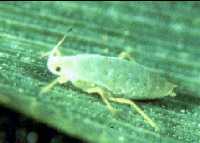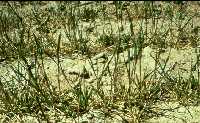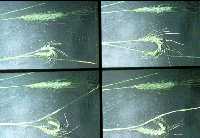by F.B. Peairs * (4/16)
Quick Facts…
- Several kinds of aphids infest small grains.
- The Russian wheat aphid (RWA) and the greenbug are the most destructive species in the state.
- Chemical control of other aphid species rarely is necessary.
- Use the key (Figure 5) to determine that aphids are present in the crop.
 |
Figure 1.The Russian wheat aphid. |
Russian Wheat Aphid
The Russian wheat aphid (RWA) was first reported in Colorado in March 1986. Good RWA management practices have emphasized resistant varieties, cost-effective use of insecticides and certain cultural practices. Resistant varieties and biological control agents have been effective enough to replace the need for insecticides in many cases, however, recent occurrence of newbiotypes have made resistant varieties much less useful.
The RWA damages small grains by injecting saliva into and sucking sap from plants. Yield losses of 50 percent or more to this pest can be expected if economic infestations are left untreated. U.S. research has shown that RWA is not an important vector of barley yellow dwarf virus or other cereal diseases.
Life Cycle
Two forms of RWA are found in Colorado during the year: a wingless female and a winged female. It is difficult to determine if an individual aphid will be winged or wingless until it is near maturity.
In Colorado, most severe spring infestations of winter grains are caused by wingless aphids that overwintered in the crop. Winged aphids begin to appear in April and May and flights peak during July in most wheat-producing areas of the state. At this time, winged aphids include both local aphids and immigrants from the south.
Winged aphids infest late-maturing winter wheat and spring grains but not corn, millet or sorghum. They also infest a number of cool-season grasses, particularly wheatgrasses. Damage to newly seeded grasses can be significant.
These grasses serve as alternate hosts for RWA during the period between grain harvest and the appearance of new wheat in the fall. Volunteer wheat and barley also may become infested. Volunteer wheat and barley are important sources of RWA for the new fall crop as soon as it emerges. Weather conditions that favor cool season grasses and volunteers will increase the number of aphids infesting the new wheat crop in the fall.
Movement to the new crop occurs in October and early November. RWA can survive the winter in most Colorado grain growing areas, except the San Luis Valley. Winter weather conditions that are detrimental to RWA in Colorado include several cycles of wet snow followed by a rapid melt and a quick freeze, prolonged exposure to temperatures below 15 degrees F, and extended periods of snow cover.
 |
Figure 2. Discoloration caused by the Russian wheat aphid. |
 |
Figure 3.Wheat plants damaged by the Russian wheat aphid. |
 |
Figure 4.“Fish hook” distortion caused by trapped awns. Each damaged head is compared to an undamaged head. |
Signs of Infestation
RWA can be found in winter wheat, usually on the younger leaves, from emergence in the fall to grain ripening. Aphid feeding prevents young leaves from unrolling. RWA colonies are found within the tubes formed by these tightly curled leaves. This not only makes it difficult to achieve good insecticide coverage but also interferes with the ability of predaceous and parasitic insects to reach and attack aphids. New beneficial insect species better able to attack RWA were identified in areas where the aphid is native. Promising species are being imported and released by the Colorado Department of Agriculture.
Leaves infested by RWA have long white, purple or yellowish streaks. Under some conditions, infested wheat tillers have a purplish color. Heavily infested plants are stunted and some may appear prostrate or flattened.
After flowering, some heads are twisted or distorted and have a bleached appearance. Heads often have a “fish hook” shape caused by awns trapped by tightly curled flag leaves. At this time, most RWA are found feeding on the stem within the flag leaf sheath or on developing kernels. There may be poorly formed or blank grains. The entire head sometimes is killed.
Cultural Controls
Although insecticides provide the most effective RWA control, several other practices can help minimize the need for chemical applications.
- Control volunteer wheat and barley. Although many grass species help RWA survive the summer, volunteers are the most important source of infestation for the new crop in the fall. Try to have a three week volunteer-free period prior to emergence of fall seedings.
- Adjust planting dates. Plant winter wheat as late as possible in northeastern, southwestern and western Colorado. Recommended planting dates have not been determined for southeast Colorado. Plant spring grains as early as possible..
- Produce a healthy, stress-free crop.RWAs often get their start in stressed fields or stressed portions of fields and cause relatively more damage to stressed plants. Test the soil and fertilize accordingly. Plant certified, treated seed. Select a variety that is well adapted to local growing conditions.
Resistant Varieties
These resistant varieties are still the most economical and effective management option for Biotype 1. Also, they are well adapted to Colorado production conditions and should be good variety choices regardless of their resistance to Russian wheat aphid. Biotypes other that Biotype 1 must be managed with the methods developed before resistant varieties were available. These include biological control, cultural controls and judicious insecticide treatments based on appropriate scouting and economic threshold information.
There are also important differences among the small grain crop species. Oats are resistant to RWA. Although heavy infestations have been observed, little economic damage has been detected. Resistant barleys have been developed including Stoneham and Sidney.
Insecticides
Insecticides recommended for RWA control are in the High Plains Integrated Pest Management Guide, which is available at https://wiki.bugwood.org/HPIPM:Main_Page. Be sure to read and follow all label directions. Insecticides may be applied at one of several times during the growing season.
Planting-Time Soil and Seed Treatments
Treatments with soil systemic insecticides and certain seed treatments can control RWA for a substantial period of time if adequate soil moisture is available. Since the fall RWA flight is expected six to eight weeks after planting, such treatments may not last long enough.
The risk of significant fall infestations is generally considered to be low in Colorado. Consider using planting-time treatments only when the risk of fall infestation is high, for example: when planting near uncontrolled volunteers, when planting early, when planting near other common alternate hosts such as one of the wheatgrasses, when planting near rangeland or CRP, or if the area has a history of fall RWA infestations.
Fall Aerial or Ground Applications of Foliar insecticides
These should be considered if more than 10 to 20 percent of the plants in a field show RWA damage and weather conditions are expected to remain favorable for an extended period. To determine the level of infestation, walk a diagonal or zigzag pattern across the field and stop at least 10 times to examine 20 consecutive plants. It also is best to examine some damaged plants for RWA, but they may be difficult to find on cooler days or during bad weather. Scout fields every two weeks in the fall. Visit a field more often if a RWA infestation is detected.
Fall control generally has been more effective than spring control. The risk of increased winter injury and some loss of yield potential if treatment is delayed until spring needs to be balanced against the possibility that RWA overwintering success will be low.
Spring insecticide Treatments
These are recommended according to the guidelines below. Plants with even a single infested or damaged tiller should be considered infested.
| Regrowth to early boot stage | 5 to 10 percent damaged and infested plants. |
| Early boot to flowering | 10 to 20 percent damaged and infested plants. |
| After flowering | More than 20 percent damaged and infested tillers. |
A more accurate method to determine the need for treatment is to walk a diagonal or zigzag pattern across the field, stop 10 times and collect 10 tillers at random at each stop. (Avoid bias in selecting tillers at each stop. For example, take the 10 tillers closest to your foot or every fifth tiller starting with the one closest to your foot). More efficient sampling procedures are described in Sampling Russian Wheat Aphid in the Western Great Plains, Great Plains Agricultural Council Publication 138.
Examine the tillers and count the number that contain RWA. This number is the percent infested tillers and can be compared to the economic threshold calculated with the following formula:
ET = (CC * 200) / (EY * MV)
where:
ET = Economic threshold or the percent infested tillers above which an insecticide application will be cost effective.
C = Control cost per acre (insecticide plus application)
EY = Expected yield per acre
MV = Market value per bushel
After flowering, substitute 500 for 200 in the numerator of the formula. If the calculated ET is lower than the percent infested tillers observed, a treatment should be cost effective. There probably is no benefit from insecticide applications made after the crop has reached the soft dough stage.
Scout fields at least weekly in the spring. Spring foliar treatments have been the most common type of treatment in Colorado. Chlorpyrifos is available in several restricted use products and has been the most consistent product commercially. Both cool temperatures and drought stress can interfere with the plant’s ability to absorb systemic insecticides. If the crop is stressed, consider using a contact insecticide alone or a contact/systemic tank mix. Avoid herbicide/insecticide tank mixes if the crop is stressed.
Make ground applications in at least 10 gallons of spray volume per acre. Aerial applications can be made in one gallon of spray volume per acre prior to jointing and after flowering. Otherwise, use 2 gallons per acre.
If greenbugs are present in the field, see the recommendations below.
Insecticide applications generally are cost effective in Colorado, but do not completely prevent yield losses.
Control of Greenbug and Other Aphids
Like the RWA, greenbugs damage small grains by injecting toxic saliva into and sucking sap from the plant. It also is an important vector of barley yellow dwarf virus. Other aphid species are important transmitters of barley yellow dwarf and other viruses and may reduce yields as well.
For economical control of the greenbug and other aphids, combine biological control, cultural practices and, if necessary, insecticide treatments. Lady beetles and parasitic wasps often keep these aphids below economically important levels.
Use the field key below to determine which aphids are infesting your crop. Descriptions of the major species as well as a list of insecticides for their control are found in the High Plains Integrated Pest Management Guide (https://wiki.bugwood.org/HPIPM:Main_Page). Minor species can be managed in the same manner as the important species.
Some greenbugs are resistant to some insecticides. Resistant greenbugs are not widespread. If a control failure is experienced, it is unlikely that control will be achieved by retreatment with the same product or a different insecticide with the same mode of action. Most insecticides currently registered on small grains have one of three modes of action. The best way to avoid such problems is to treat greenbug infestations only when they exceed action thresholds. Ask your local Colorado State University Extension county office or other reliable source whether greenbug failures have occurred in your area.
Field Key to Important Small Grain Aphids*
-
- A. Cornicles long and tubular in shape. Go to 2.
B. Cornicles very short and rounded. Go to 8.
- A. Cornicles long and tubular in shape. Go to 2.
-
- A. Body greenish, yellowish or pinkish. Go to 3.
B. Body dark, chocolate brown. Rusty plum aphid.
- A. Body greenish, yellowish or pinkish. Go to 3.
-
- A. Red coloration on abdomen. Go to 4.
B. No red coloration on abdomen. Go to 5.
- A. Red coloration on abdomen. Go to 4.
-
- A. Antennae with five segments and long fine hairs. Rice root aphid.
B. Antennae with six segments and short antennal hairs. Bird cherry-oat aphid.
- A. Antennae with five segments and long fine hairs. Rice root aphid.
-
- A. Cornicles relatively long, almost reaching the tip of the abdomen. Go to 6.
B. Cornicles relatively short, shorter than the distance to the tip of the abdomen. Go to 7.
- A. Cornicles relatively long, almost reaching the tip of the abdomen. Go to 6.
-
- A. Cornicles all black. English grain aphid.
B. Cornicles black just at the tips. Rose grass aphid.
- A. Cornicles all black. English grain aphid.
-
- A. Cornicles dusky. Corn leaf aphid.
B. Cornicles black just at the tips. Usually with a darker green stripe on back. Greenbug.
- A. Cornicles dusky. Corn leaf aphid.
-
- A. Shiny brown to black aphid, spiny appearance under magnification. Hedgehog grain aphid.
B. Spindle-shaped gray to green aphids, usually associated with tightly rolled and discolored leaves. Go to 9.
- A. Shiny brown to black aphid, spiny appearance under magnification. Hedgehog grain aphid.
- A. When viewed from side, a single projection from the tip of the abdomen. Waxy, gray appearance. Western wheat aphid.
B. When viewed from side, a double projection from the tip of the abdomen. Greenish appearance. Russian wheat aphid.
*This key requires observations of aphid cornicles, which are tubular structures found at the rear of the aphid, and antennae. In some aphids the cornicles are easily observed, while in others they are greatly reduced in size. You will need to observe the cornicles through a 10X hand lens before you go through the key.
*Colorado State University Extension entomologist and professor, bioagricultural sciences and pest management, emeritus. 6/98. Revised 4/16.
Colorado State University, U.S. Department of Agriculture and Colorado counties cooperating. Extension programs are available to all without discrimination. No endorsement of products mentioned is intended nor is criticism implied of products not mentioned.
Go to top of this page.





